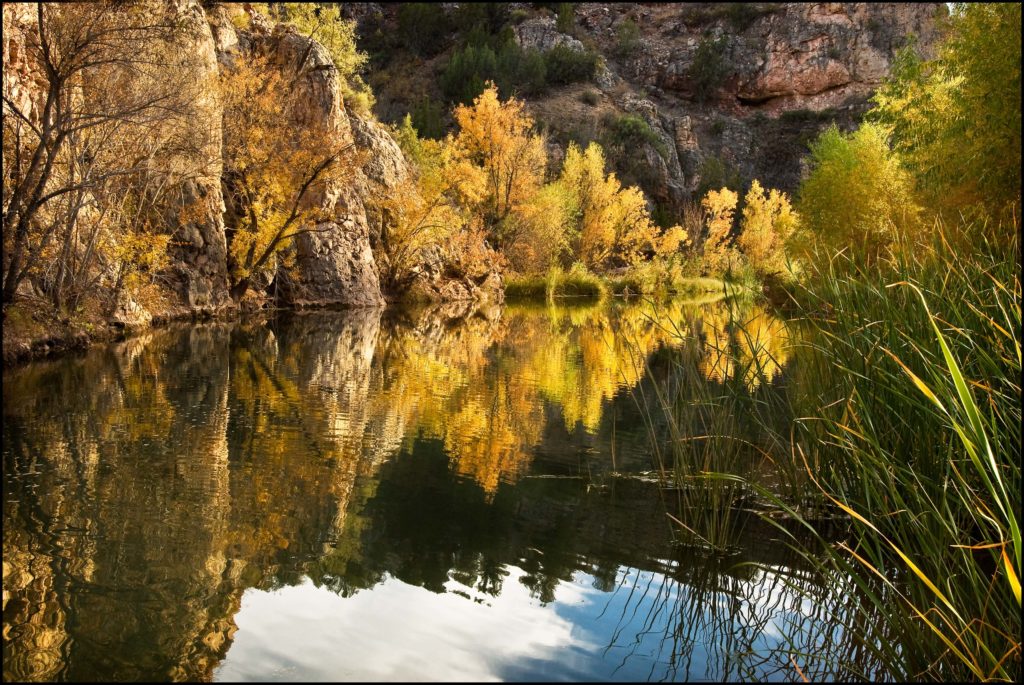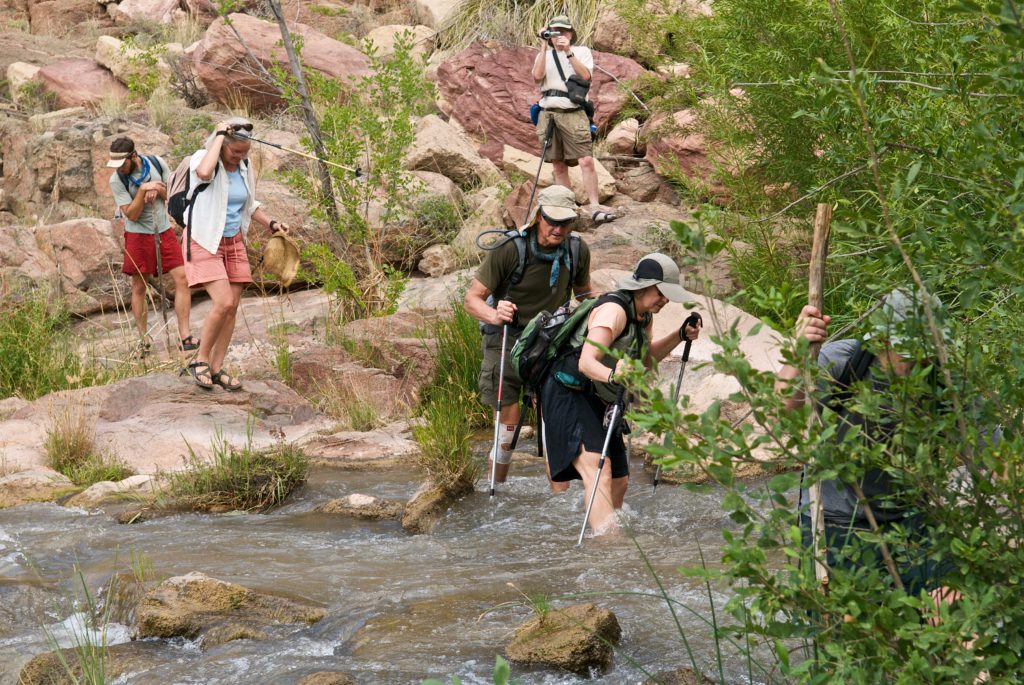Values of the Upper Verde River
Wild and Scenic Rivers must contain at least one Outstandingly Remarkable Value, also called “ORVs”. The 1968 Wild & Scenic Rivers Act states the following:
“It is hereby declared to be the policy of the United States that certain selected rivers of the Nation which, with their immediate environments, possess outstandingly remarkable scenic, recreational, geologic, fish and wildlife, historic, cultural or other similar values, shall be preserved in free-flowing condition, and that they and their immediate environments shall be protected for the benefit and enjoyment of present and future generations.“
Learn more about the Upper Verde River’s ORVs below!

The Upper Verde River is one of the most beautiful areas in the state of Arizona; displaying green meadows, red rocks, blue sky, fall colors, white clouds, and deep canyons, plus hosting a vast diversity of wildlife – all unique features of a rare southwestern riparian corridor.

Recreational opportunities along the Upper Verde River include hiking, backpacking, kayaking, canoeing, paddle-boarding, horseback riding, photography, wildlife viewing, swimming, camping, fishing, hunting, riding the scenic railroad, and interpretation or observation of geological, cultural, and ecological features.
The native fish known to currently occur in the Upper Verde River include roundtail chub, Sonora sucker, desert sucker, longfin dace, and speckled dace. The river contains designated Critical Habitat for razorback sucker, spikedace and loach minnow, all protected by the Endangered Species Act. There have been surveys for aquatic wildlife species, including northern Mexican garter snake, narrow-headed garter snake, Arizona toad, and lowland leopard frog (known mainly from tributaries). The Verde River was historically home to one of the most diverse populations of native fish species in Arizona. Nonnative fish species present include redeye bass, flathead catfish, channel catfish, yellow bullhead, green sunfish, common carp, red shiner, mosquitofish, and fathead minnow – these species are a threat to the viability of native fish.
The Verde Valley, one of the three great valleys in the Transition Zone, is regionally significant as a unique physiographic feature revealing intermixture between the Colorado Plateau and the Basin and Range province. Remarkably, hiking along the river bank on the Great Unconformity, a hiker can stand on Precambrian granite and simultaneously touch Tapeats sandstone, bodily bridging a one-billion-year gap in the geologic record.
Vegetation communities and geography along the riparian zone of the Upper Verde River constitute a unique, essential, continuous wildlife corridor connecting the Sonoran Desert with the highlands. This creates a unique mixture of vegetative habitats for animals and preserves the rich biodiversity of the watershed. The watershed supports a substantial part of Arizona’s vertebrate wildlife. The Upper Verde has recorded sightings of 270 migratory and year-round birds and 209 breeding bird species. Species protected by the ESA include the Western yellow-billed cuckoo (Coccyzus americanus occidentalis), the southwestern willow flycatcher (Empidonax traillii extimus), the Mexican gartersnake (Thamnophis eques megalops), the narrow-headed garter snake (Thamnophis rufipunctatus), the Gila chub (Gila intermedia), the loach minnow (Rhinichthys cobitis), the spikedace (Meda fulgida), and the razorback sucker (Xyrauchen texanus). Species rated sensitive by Prescott National Forest include the common black hawk (Buteogallus anthracinus), the American peregrine falcon (Falco peregrinus), Abert’s towhee (Pipilo aberti), Western red bat (Lasiurus blossevillii), Pale Townsend’s big-eared bat (Corynorhinus townsendii pallescens), the pocket free-tailed bat (Nyctinomops femorosaccus), the lowland leopard frog (Rana yavapaiensis), and the Arizona toad (Bufo microscaphus microscaphus). The Arizona Game and Fish Department has identified several Wildlife Species of Concern: the candidate least bittern (Ixobrychus exilis), the river otter (Lontra canadensis Sonora), the Belted kingfisher (Megaceryle alcyon), and the fringed myotis (Myotis thysanodes) bat.
Archaeological sites along the Upper Verde River are directly tied to the people who once lived in harmony with the river. The reason the Upper Verde River has such a high density of archaeological sites is because the Yavapai and Apache people relied on the river for survival.
Prescott National Forest internal reports document 54 heritage resources along the Upper Verde between the western and eastern Prescott National Forest boundaries, all of which would qualify for the National Register of Historic Places. There are at least eight additional sites within the Upper Verde west of the Prescott National Forest boundary plus many more sites along Sycamore Creek and Sycamore Canyon spring (‘Che’L chi Bis Bitu’ in Apache, meaning ‘red cliff spring’) that were not counted in their report. To this day, the Yavapai and Apache people regard the river and the springs as an essential part of their character, culture, and spirituality.
Tu cho n’Lii (“big water that flows”) is the Apache name for the Verde River. Apache Elder and Director of the Apache Cultural Office, Vincent Randall, shares that when he was a child the river was 10-15 feet deep in areas where today it is no longer that way. He fears the river he knows and loves may soon no longer flow above the surface. The river and the springs where it originates are very important to the Apache people for many reasons. In the Apache philosophy, “water is life” and the Creator is known as the “ruler of life.” The Creator is a living entity. All his creations and all things are living and, therefore, we must respect them. When Apache people say water is life, we are saying “water is living” and therefore must be respected. In the Apache creation story, the father of one of the first Apache was a spring. Therefore, water is the beginning of life for the Apache people, or as Mary Sine, a Yavapai-Apache Elder said, in the 1930’s, “as long as the river flows, life will be good.”
The entire length of the Upper Verde is also rich in settler history, from the historic railways to homesteads and cattle ranches. Over 100 years of ranching history is represented in this river corridor by numerous historic corrals, homesteads, and ranch buildings, weathered but still standing. Ranching families that have been in the area for generations are still active in the watershed, raising cattle on private lands and U.S. Forest Service grazing leases.
The Upper Verde River hydrology is regionally significant because it is one of the last free-flowing undeveloped rivers in the Southwest. The hydrology and riparian ecology of the region are nationally significant because of the river’s flash flood regime, a consequence of the climate and the absence of dams.
The Upper Verde River hydrology is also unique in that the river’s headwater aquifer underlies grasslands, whereas most western rivers originate in mountains.
The Upper Verde’s base flow supports an ecologically important riparian corridor with a diverse vegetative community functioning in relatively pristine, intact conditions. These waters create an oasis in the arid lands of Central Arizona and supporting a rich diversity of species. Riparian areas provide the harsh desert climate with water, cover, shade, and travel corridors for hundreds of species.